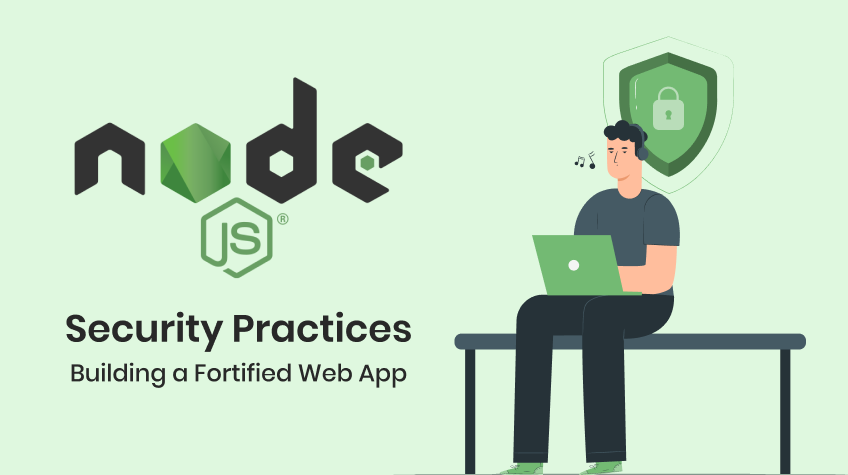
Introduction
In the ever-evolving web development sphere, Node.js emerges as a potent platform, enabling dynamic and scalable applications. Yet, in the digital realm, security is paramount. Welcome to our exploration of “Node.js Security Practices: Building a Resilient Web App.”
This blog unveils 15 crucial security practices empowering developers against potential threats. Join us as we delve into securing Node.js applications, ensuring code integrity, and fostering user trust.
What is Node.js?
Node.js, a revolutionary runtime, reshapes server-side JavaScript execution. Built on Chrome’s V8, it empowers high performance, scalable applications. Operating on a non-blocking, event-driven model, Node.js facilitates efficient code execution.
Its versatility spans server-side scripting to real-time applications, promoting seamless communication and productivity. This open-source marvel has become synonymous with ingenuity, propelling the modern web ecosystem.
What is Node.js security?
Node.js security safeguards applications within its runtime. Mitigating risks, it addresses dependencies vulnerabilities and guards against unauthorized access. Measures extend to shielding against web threats like XSS and injection attacks.
Node.js security involves robust authentication, secure communication, and continuous monitoring. Embracing practices like routine updates, input validation, and security headers adherence ensures resilience against cyber threats.
Why prioritize Node.js security?
Prioritizing Node.js security is indispensable for fortifying applications. Widespread adoption and event-driven architecture make Node.js a target for malicious actors—robust security safeguards against breaches, unauthorized access, and
exploitation.
Routine updates, secure coding, and encryption ensure confidentiality, integrity, and availability. Proactive security shields sensitive data upholds user trust and protects businesses. In the interconnected digital landscape, securing Node.js is essential for resilient web applications.
15 Node.js Security Practices
Here are the 15 Node.js Security Best Practices
1. Secure Dependencies Management
In the realm of Node.js security, meticulous management of dependencies is paramount. Firstly, regularly updating Node.js and npm ensures the incorporation of the latest security patches and performance enhancements. Secondly, implementing a
dependency checker tool becomes a proactive shield, scanning for vulnerabilities in third-party packages before they compromise the system.
Lastly, continuous monitoring and swift patching of vulnerabilities in these packages serve as a dynamic defense mechanism, preventing potential exploits. This trifecta of practices fortifies the application against emerging threats and fosters a resilient
foundation for secure and reliable Node.js-based web development.
2 . Authentication Best Practices
In the realm of Node.js security, Authentication Best Practices serve as an impenetrable
fortress for user data:
- Employing robust password hashing algorithms ensures the confidentiality of user credentials, thwarting unauthorized access.
- Implementing Multi-Factor Authentication (MFA) adds an extra layer of defense, fortifying accounts against compromise.
- Enforcing secure password recovery mechanisms strikes a delicate balance between accessibility and protection, preventing potential avenues for exploitation.
By embracing these practices, Node.js applications authenticate users securely and elevate the authentication process’s overall resilience, safeguarding sensitive information in the digital landscape.
3. Authorization Controls
Authorization Controls in Node.js is the vanguard against unauthorized access and data breaches. Adhering to the Principle of Least Privilege ensures that users and processes only have the permissions necessary, minimizing potential damage.
Proper access controls further fortify this defense, regulating who can access what within the application. Regularly reviewing and updating permissions adds a dynamic layer of security, adapting to evolving roles and responsibilities. These meticulous
controls bolster the security posture and instill confidence in users, ensuring their access is precisely calibrated for functionality without compromising the system’s integrity.
4. Input Validation and Sanitization
Input validation and sanitation in Node.js provide a robust defense against malicious
exploits. Validating and sanitizing user inputs act as a frontline filter, ensuring only expected and safe data enters the application, preventing vulnerabilities. Implementing parameterized queries thwarts SQL injection attacks by separating data from SQL
commands.
This approach establishes an effective barrier against a spectrum of threats, safeguarding the integrity of data and the stability of Node.js applications.
5. Cross-Site Scripting (XSS) Protection
Guarding against Cross-Site Scripting (XSS), Node.js fortifies its defenses with three vital practices:
- Implementing Content Security Policies erects a digital barricade, dictating the permissible sources of executable scripts.
- Meticulous sanitization and escaping of user-generated content neutralize potential script injection vulnerabilities, preserving the sanctity of the application.
- The commitment to regular audits and updates of XSS prevention mechanisms ensures adaptability against emerging threats.
By intertwining these practices, Node.js not only shields against script-based attacks but also pledges a steadfast commitment to the ongoing security resilience of web applications.
6. Cross-Site Request Forgery (CSRF) Prevention
Node.js fortifies itself against Cross-Site Request Forgery (CSRF) through a triad of defensive strategies. Firstly, implementing anti-CSRF tokens serves as a sentinel, validating the authenticity of requests and mitigating unauthorized actions. Ensuring that
state-changing requests necessitate user authentication acts as a second line of defense, securing critical transactions.
Additionally, education is crucial as developers are enlightened on CSRF prevention best practices, fostering a proactive security culture. These intertwined measures underscore Node.js’s commitment to shielding applications from illicit manipulations,
elevating the security posture, and inspiring confidence in user interactions.
7. Secure File Uploads
Securing file uploads in Node.js demands a multi-faceted strategy. Start by limiting file types and sizes to prevent the introduction of harmful content. Utilize a dedicated file server with precise permissions for secure storage and protection against unauthorized access.
Implementing malware scanning for uploaded files adds an extra layer of defense by actively detecting and eliminating potential threats before they compromise the system’s integrity. These measures collectively exemplify Node.js’s commitment to establishing a resilient defense against security vulnerabilities in the crucial domain of file uploads.
8. Secure Communication
Securing communication in Node.js is foundational for safeguarding sensitive data. Utilizing HTTPS encrypts data during transit, ensuring confidentiality against potential interceptions. Employing secure protocols and ciphers fortifies the integrity of
transmitted data, thwarting eavesdropping attempts.
Regularly updating SSL/TLS certificates provides ongoing resilience, mitigating the risk of exploits. These measures exemplify Node.js’s steadfast commitment to secure communication, establishing a framework where data confidentiality and integrity are prioritized, and ensuring a robust and trustworthy environment for web applications.
9. Logging and Monitoring
Node.js security hinges on vigilant Logging and Monitoring practices. Thorough logging captures security events, facilitating timely threat detection. Real-time monitoring identifies unusual activities, acting as a proactive guardian against potential breaches.
Incident response procedures provide a systematic approach to mitigate damage and restore security in case of a breach. These practices fortify Node.js applications, allowing them to detect, respond, and adapt to evolving security challenges with
precision and efficiency.
10. Protect Against Denial of Service (DoS) Attacks
Guarding against Denial of Service (DoS) attacks is crucial in Node.js security. Rate limiting and throttling act as a strong gatekeeper, preventing excessive requests from overwhelming the system. Using load balancers ensures even resource allocation, mitigating potential impacts.
Employing DDoS protection services adds an extra shield against distributed attacks. These measures underscore Node.js’s commitment to uninterrupted service, fortifying applications against the disruptive force of DDoS attacks and preserving the reliability of the digital infrastructure.
11. Security Headers
In Node.js, security, fortifying through Security Headers is paramount. Implementing HTTP security headers establishes a first line of defense, dictating browser behavior for enhanced security. Features like Strict-Transport-Security (HSTS) ensure a secure
connection, safeguarding against potential man-in-the-middle attacks.
Regularly reviewing and updating security headers provides a dynamic defense, adapting to emerging threats. These practices exemplify Node.js’s unwavering commitment to cultivating a robust security posture, where the strategic deployment and
continuous refinement of security headers bolster the protective shield around web applications.
12. Session Management
Node.js security underscores the essence of Session Management. Secure, random session IDs fortify against predictable patterns, enhancing resilience against session hijacking. Session timeout mechanisms provide a proactive defense, automatically
terminating inactive sessions to mitigate unauthorized access.
Storing session data securely safeguards sensitive information, preventing potential data breaches. These cohesive measures exemplify Node.js’s commitment to a robust and secure session management framework, providing a fortress against threats and instilling confidence in users that their sessions are diligently protected in the dynamic
digital landscape.
13. Continuous Security Testing
In Node.js security, Continuous Security Testing is an ongoing commitment to resilience. By seamlessly integrating security testing into the development lifecycle, Node.js applications undergo perpetual scrutiny, minimizing vulnerabilities—regular
penetration testing probes for weaknesses and identifying potential entry points for malicious actors.
Automated security scanning tools provide a dynamic defense, rapidly detecting and mitigating emerging threats. This continuous testing approach exemplifies Node.js’s dedication to proactive security, ensuring that applications evolve alongside potential risks, fortifying the digital infrastructure, and instilling confidence in users who rely on
the reliability and security of Node.js-based solutions.
14. Developer Training and Awareness
Developer Training and Awareness in Node.js security is a cornerstone for a robust defense. Regular security training cultivates a skilled and vigilant developer community equipped to identify and mitigate potential threats. Fostering a security-conscious
culture instills a proactive mindset within the development team, where security is not just a practice but a shared responsibility.
This commitment ensures that each line of code is crafted with a security-first approach, fortifying Node.js applications against vulnerabilities. The emphasis on knowledge and culture underscores Node.js’s commitment to proactive security, creating a resilient environment where developers are the first defense against emerging threats.
15. Content Security Policies (CSP) Implementation
In Node.js security, Content Security Policies (CSP) Implementation is a pivotal defense mechanism. By defining and enforcing strict content security policies, Node.js fortifies against unauthorized script executions and potential security breaches. This proactive measure creates a secure environment, dictating browser behavior to safeguard against malicious content.
Utilizing nonce values and hashes ensures meticulous control over script and style sources, further solidifying the protective shield. Regularly reviewing and updating CSP rules demonstrates Node.js’s commitment to adaptability as it evolves alongside
emerging threats and application requirements, reinforcing the integrity of web applications and establishing a resilient defense against a spectrum of security challenges.
Conclusion
In the dynamic landscape of Node.js security, the culmination of these 15 practices forms an impenetrable fortress against potential threats. From securing dependencies to vigilant monitoring, each measure is a sentinel guarding the sanctity of web
applications.
The commitment to continuous improvement, education, and proactive testing in Node.js development services reflects Node.js’s dedication to staying ahead of emerging risks. Together, these practices fortify the digital infrastructure and instill confidence in users. In the ever-evolving realm of cybersecurity, Node.js stands as a bastion of resilience, ensuring that applications function precisely within an unwavering security environment.






